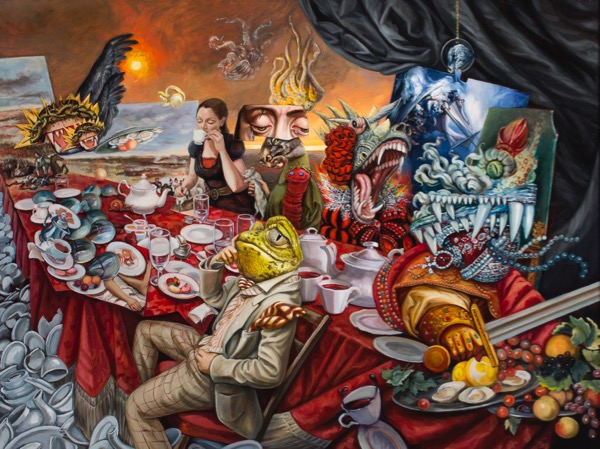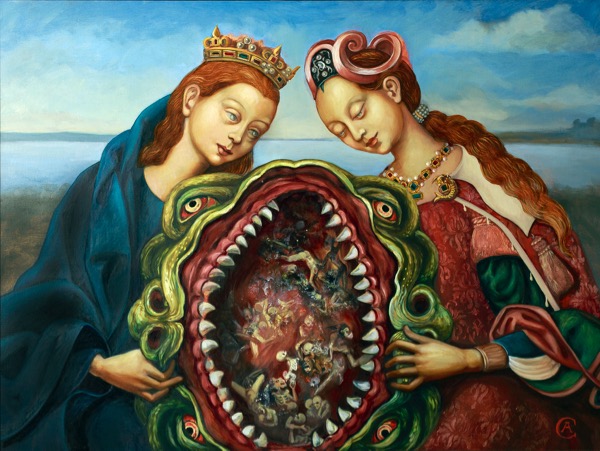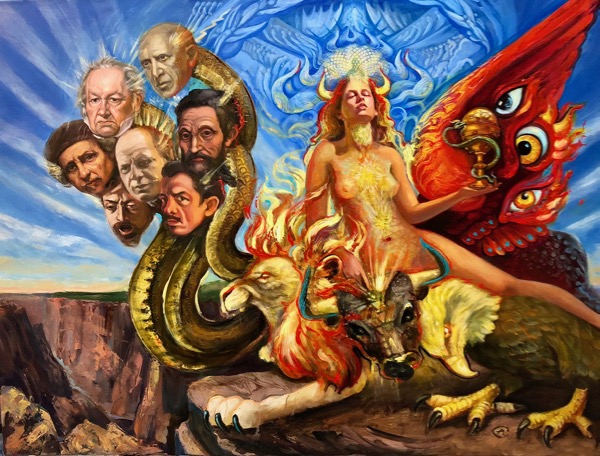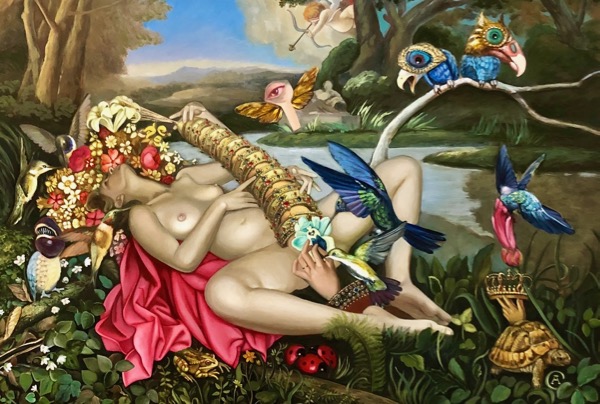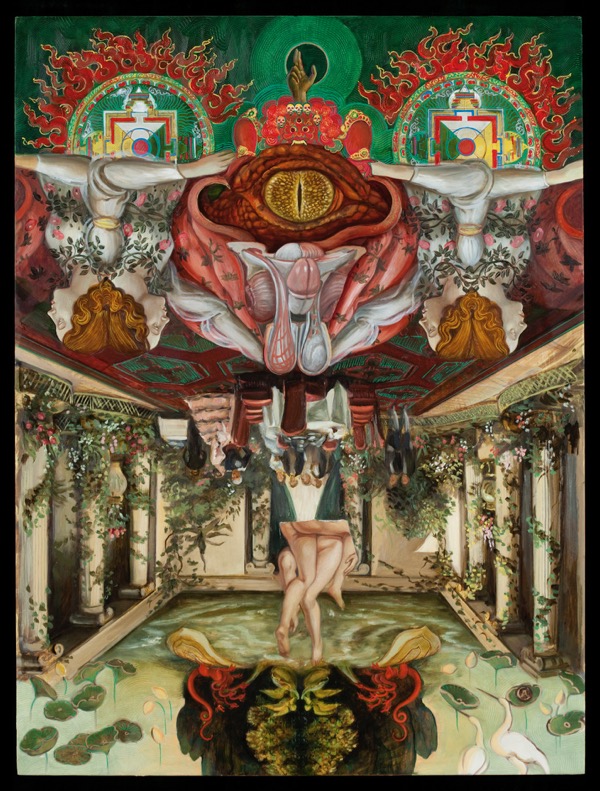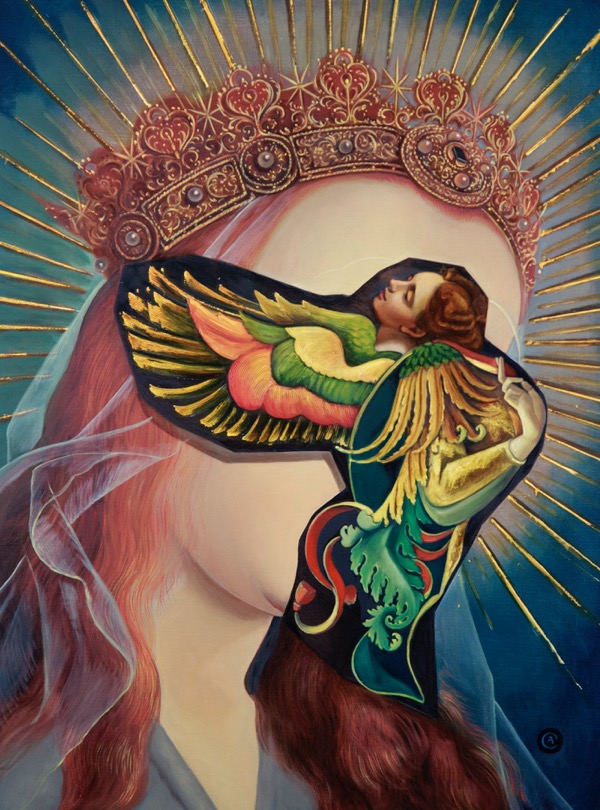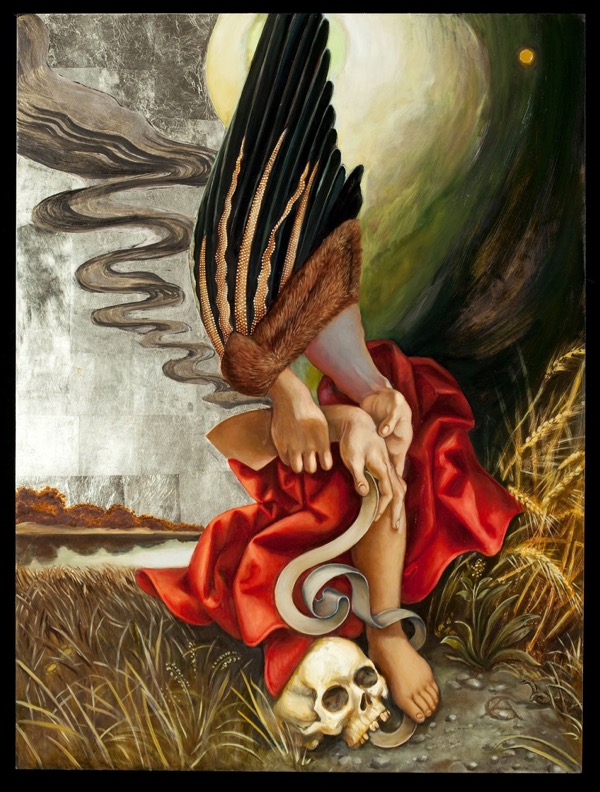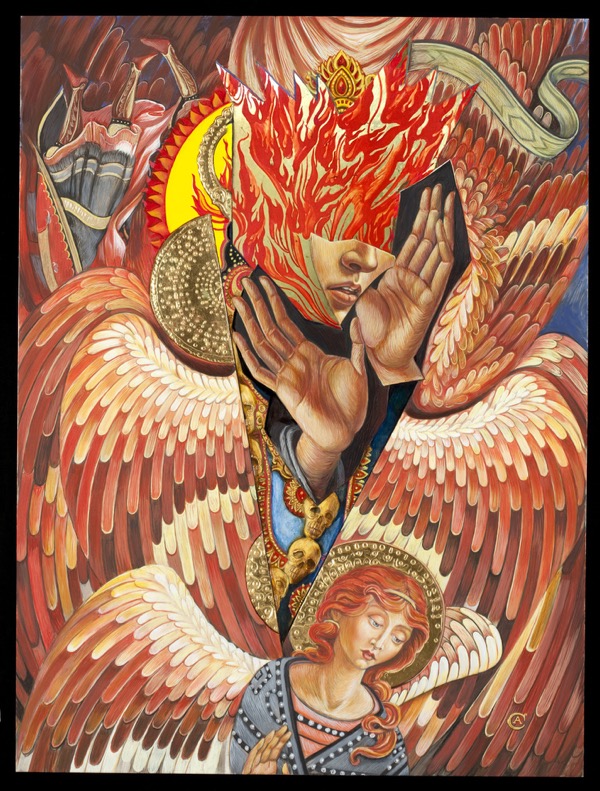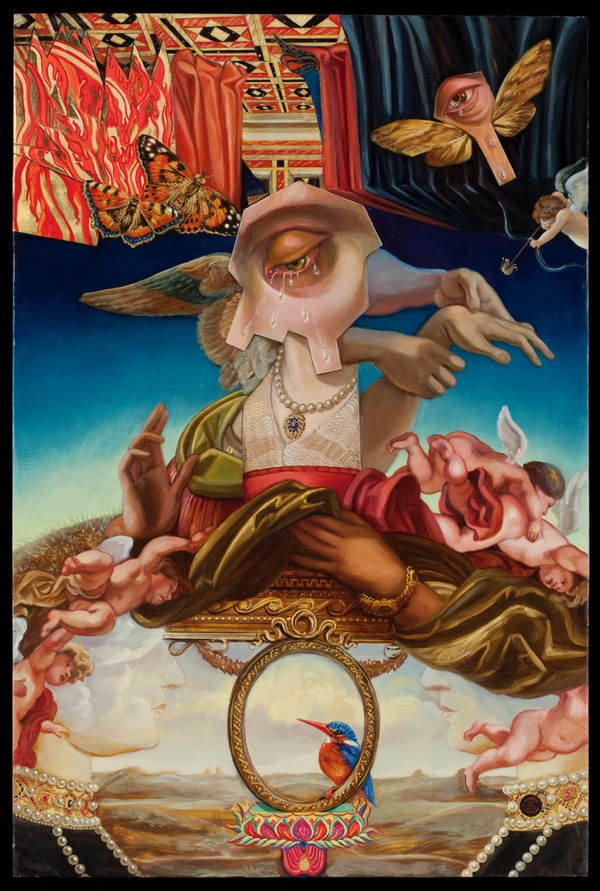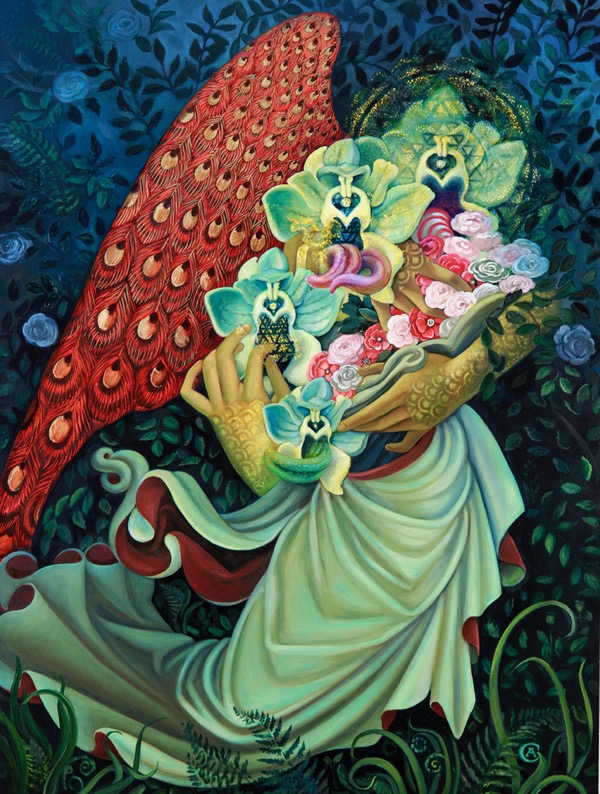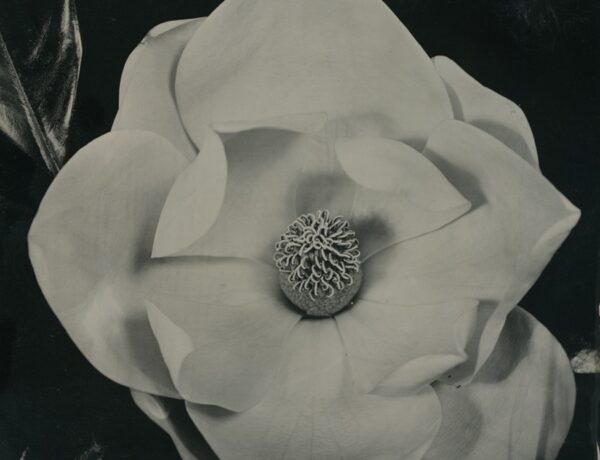While the idea of blasphemy is usually tied to religion, it can also be applied to long-held traditions that society also holds sacrosanct. In the paintings of Carrie Ann Baade, blasphemy is used alongside brushes and oils as another tool to deconstruct the Western canon of art history, especially when it comes to the question of where have the women’s spaces been within it. Let’s be clear though, Carrie Ann’s new work isn’t about corresponding with the past nor realizing better futures but rather processing and utilizing the knowledge we have to make the most of the present.
While this hasn’t always been explored in her earlier work, Carrie Ann has been pushing her unique process away from internal, autobiographical meditations within historical and visionary symbolism, and has moved towards more universal and aggressive feminist themes through the lens of refocusing the male gaze into a female sexual self-actualization. Gone are the contemplative and sorrowful bluestockings. These new canvases feature emboldened and gratified Lilith’s returned to their rightful gardens. The result: 13 thought-provoking pieces that have been, collectively, 7 years in the making touring the country in 5 major solo exhibitions throughout this year and next.
This new turn in Carrie Ann’s artistic vision celebrates an enviable and impressive career. She has received grants from the Florida Division of Cultural Affairs Individual Artist Fellowship and the Delaware Division of the Arts Fellowship for Established Artists. She’s also been been nominated for the United States Artists Fellowship and the Joan Mitchell Grant. Her work has exhibited in major museums like the Ringling Museum of Art, The Delaware Contemporary, Museum of Contemporary Art in Jacksonville, as well as countless galleries on the fore of the Pop Surrealism, Low-Brow, and contemporary surrealist front. Internationally, her work has traveled to Mexico, Austria, Poland, Germany, France, Spain, Japan, and to the Ningbo museum in Shanghai, China. It was here that Carrie Ann was one of three first American artists to exhibit in 2007.
I was able to catch-up with Carrie Ann in her studio in Tallahassee, FL, right before she left for LA for her first solo exhibit, The Apocalyptic Orgasm, at La Luz de Jesus. She was also kind enough to follow-up with me on the experience of the La Luz opening, as well as give Beautiful Bizarre Magazine an exclusive to the most recently completed images. We had an enlightening and inspiring discussion, not only about the new work, but also about how to keep the artist’s spirit alive through harrowing life-changing events, and how we can all break norms with a little dab of blasphemy.
First, tell me which of the 13 paintings are your favorite?
Those would be Hellmouth, The Queen of Heaven: The Creative, Parthenogenesis of the Muse (Homage to Ol’ Master-bation, and Angel of Paradox: Suck my clit, Georg Baselitz. Hellmouth is a fanciful exploration of the monstrous female as a giant hellmouth, envisaged as a gaping mouth, but also as a vagina dentate, which is a concept that comes from folk tales featuring vaginas containing teeth that threaten men with emasculation or castration during intercourse. In a patriarchal and phallocentric ideology, women have been viewed as monsters as far back as the writing of Aristotle who stated that “Woman is literally a monster: a failed and botched male who is only born female due an excess of moisture and coldness during conception.”
The Queen of Heaven: The Creative is a retelling of the Whore of Babylon from Revelations. But with the seven-headed beast featuring some of the old masters: Michelangelo, Caravaggio, Rembrandt, Goya, Picasso, Thomas Hart Benton, and Jackson Pollack. Historically, women have been portrayed as the muse and rarely as the artist, so, as a former artist’s model, I have taken the opportunity to show the power of the muse-woman as a great divine force of the artistic process. The muse is the power of inspiration and the conduit for imagination. She is the goddess riding the artist.
Parthenogenesis of the Muse is a female nude with a stacked, papal tiara codpiece and flower-like vaginal opening. This work is about the self-inspiring (masturbation) or fertilization of the female muse. When not engaged in the giving of her light to a male artist, the muse has the option to self-fecundate with proper stimulation. This rare pseudo-hermaphroditic state allows her to fertilize her own imagination thus attaining the dual role of both muse and artist.
Angel of Paradox (Suck my clit, Georg Baselitz) teases at the “woman’s problem” by playing with the sexes and on words with one-eyed monsters and other idiomatic iconography. A response to painter Georg Baselitz’s statement in 2013 that “Women don’t paint very well,” he backed up his claim by saying that women don’t pass “the market test” or “the value test.” The logic that the quality of art is determined by its price is flawed. When this painting is sold, I’m going to donate the money towards educational scholarships for female painting students.
There has always been something of the feminine or the sacred feminine in your work, but in these new pieces I’m seeing that amped up with anger and defiance, and into a strong, staunch feminist declaration.
I had to honor getting more and more feminist. The #MeToo movement is really changing the context for our business relationships, our family relationships, and how we interact with sex in our society. I was surprised to find my themes changing in my work and they were doing this over the past five years. Paintings don’t pop up as response to headlines, but these paintings have been germinating and felt strangely on time to be exhibited this year. Like Parthenogensis of the Muse was started in 2013…it took 5 years…the Queen of Heaven also took 4 years…so it’s interesting how artists function responding to ideas, tropes, memes, that are happening in society, and very often they are predictive of what’s going to occur.
I agree, and feel an especial affinity to Partheongensis of the Muse. When I first saw it, I felt like I saw my own career and all the mixed feelings that I’ve struggled with trying to write out of the male canon. And with these works, I see you fighting the same canonical, patriarchal presence.
The parenthetical part of the title of Parthenogenesis of the Muse is “Ol’ Masterbation” because it’s about revering old masters and comparing this to masturbation, this practice of trying to paint like them but it’s not the same; something is missing. I have written about how you can’t abandon painting, all of painting’s history comes with painting–all painting comes from painting; you can’t make a new painting; painting is about painting is about painting. I think women have been trying to answer: How does one paint as a woman painter? How do you paint as a woman if all painting has been male? Clearly, I am not the first person to think about this, but they are questions I am addressing for myself.
Parthenogenesis and Queen of Heaven took 4-5 years. How long has this series been underway?
Some of these started being composed in 2011. Five of them were completed for the Ringling Museum exhibition in 2015, but the way that happens is—I’m starting to refer to paintings as being “green” like an apple, like they will get riper? Some paintings are exhibited kind of “green” and I keep repainting them. What’s nice about this exhibition at La Luz is some paintings, in my estimation, are finally completed. And it’s not just about resolution, it’s like the imagery became more complex, and they are exactly what I intended them to be, but it was, perhaps, shocking to me that it took six years to complete this body of work.
What is your process to completion?
I almost always see a vision in my head and then try and make a very crude drawing to capture what I see, then go and find the collage materials to make that vision real. It also means I have to be or become a very technical painter of trompe l’oeil. Then I have to become this amazing realist who can do trompe l’oeil of a collage…someone who is quoting, appropriating, utilizing other source material, in order to Frankenstein my own work into existence. That’s a lot; the nice thing from having all of that process is, I think, it would be very little for wholesale imitation because anyone who would attempt that process would have to be pathologically insane.
With the La Luz exhibit, you are celebrating much more than the completion of these paintings; you are celebrating the renewal of an important relationship with Pop Surrealism and the gallery, but also the rebirth of yourself. Would you mind sharing what was going on during this regenerative period?
I use my role as an educator to try and figure out what is/was Pop Surrealism and Lowbrow. The thing about being in a movement is that it’s moving. So, it’s also fascinating in that -moment by moment- it’s changing and who tells the story influences what it means. Pop Surrealism has not become a topic of art history yet, and furthermore they don’t even have their own entry on Wikipedia; it’s mentioned under Lowbrow art but really it’s its own thing. When we are taught art history in school it’s all nicely taxidermied or it’s an act of ventriloquism, but by being associated with this movement I’m trying to figure it out for myself, and how I relate to what that means. Not that I label myself as Lowbrow or Pop Surreal as such, but I did exhibit in this scene and I want to understand it better, but also so I can lecture about its origins and evolution to my students because it embodies valuable lessons about art and how culture is made.
It’s a fascinating moment in recent art history where counter culture, kitsch and narrative art collided. So, now its 2018, I feel like I have some perspective but part of my goal, for going back to La Luz is to give this lecture to Billy and ask him, “Do I have this right? Is this what you would agree with?” Do I finally understand what happened? Billy has been called the Peggy Guggenheim of the Lowbrow scene because of how he championed the artists of this scene…so he’s one of the experts. When I was looking for a gallery to work with in 2005, he was the one I wanted to work with most when he had this white wall place called Billy Shire Fine Art. This was because of his affinity for narrative art, which was making a comeback after being marginalized for the latter half of the 20th century. However, I am not from California and I don’t have many roots in lowbrow. Without Billy’s perspective, it’s a challenge for me to understand what’s happening in California in the 80’s and how this paved the way for what would become Pop Surrealism by the turn of the millennium. Billy is a tastemaker and champion of counter-culture when the world was looking to LA for what was cool. This story is important to me because narrative art died during the 20th century in America and how and why it returned are important pieces of the puzzle.
I showed with Billy from 2005 to 2011. In the Great Recession, Billy Shire Fine Art closed and he expanded La Luz de Jesus, which is part of the Wacko/Soap Plant, which is a megastore for art, art merchandise, and kitsch. I exhibited there once or twice and then I left the gallery. I didn’t leave for another commercial gallery, I just didn’t come back. What I could not say at the time was I had injured my back so bad that I didn’t know if I’d exhibit with them ever again because I physically could not paint like I did before. I didn’t know how long the injury would last. So when I talked with Billy in 2016, after a five year hiatus, it was an opportunity to reconnect. It was nice, and he told me that they would show my work again. After exhibiting full time for the past 15 years, I have a deeper appreciation for Billy’s aesthetics that embrace religious art and sexually deviant subject matter. I knew that my new work, perhaps now more than ever, would be appreciated at La Luz de Jesus.
Do you want to talk about the injury?
It was 4 years before there was any relief and it took 6 years before I was not in daily pain.
Before, I painted 30 painting that year and could sit for up to 70 hours straight working at my easel. The next day, I was bed ridden. I could not sit or drive without being in horrible pain. With every physical act, I reinjured. In the past, I painted through pain and loss, I thought I had endured some amazing hurdles and in a moment of someone else’s carelessness, I was taken out of my routine. I was jumped in a parking lot; weirder yet, it was by two people I knew. They ran at me and I think meant to hug me, but these two men sandwiched me in a berserk, aggressive embrace and then one jumped up and wrapped his legs around us and squeezed. The combined pressure and weight left me in horrible pain, thousands upon thousands in bills, and a loss of identity…I was no longer a painter because I could not paint.
It was the end of my prior world, and the beginning of a different one. As a result, I did a lot of performance art and made a cult called Art Nunz. In my head, I edit and continue to edit this time period. It’s not a simple narrative but it was necessary to redefine and reinvent who I was in order to continue making art. Not painting everyday felt like death; I never wanted to know who I was if I wasn’t a painter.
While I could not sit at an easel until 2014, I was working on really big paintings in my head or on paper and in preparatory studies and they were being worked on in 2012, 2013, and 2014, but they were not in finished form until 2015. When you are use to this online presence and the likes and endorphins and the algorithms and you don’t exist and have nothing to show, you are erased and invisible and you don’t count—the other reality is that I was working on things in my head and some in collage. I wanted to make something that could absorb all of life’s lessons I was experiencing and I didn’t want to make little paintings anymore. So I guess you could look at this ironic, paradoxically calamity as a good thing. I don’t want to be the painter I was before. Yet, those men never apologized and I am not sending them a thank you card.
How was the experience at La Luz? What’s next on the painting horizon?
It is a wonderful experience to continue to show with Billy Shire, someone who understands art’s history and its context. Billy has supported and continues to support emerging female artists; I think people forget how hard it is to have a life long career in the arts and he is dedicated to those who create with quality and have vision. La Luz de Jesus has a new Director, Matthew Gardocki (formerly of Mark Moore Gallery and Patrick Painter Gallery) who brings 25 years of experience from the international art market. This is a new era for this gallery that is the home of Lowbrow and Pop Surreal.
Now, I am back in the studio and working on large paintings that are 7 x 5 feet. At 44, it feels like I need to push the scale and the subject matter. I spent time experimenting in the past few years and now I want to apply these methods and approaches. Last night, I showed my husband something that that I wanted to paint and he said, “It’s blasphemous but most of your work is blasphemous.”
Upcoming Exhibition Information:
September 28–December 15, 2018: A Foreshadowing of Events, Gadsden Art Center and Museum, Gadsden, FL
November 2-28, 2018: The Gospel of Sophia, The Jung Center, Housten, TX,
January through April: Angels and Carnivorous Flowers, Mesa Contemporary Museum of Art, Mesa, AZ


